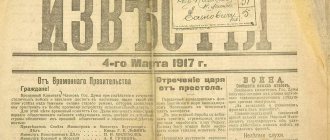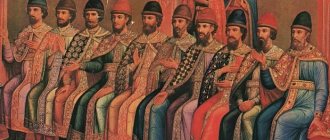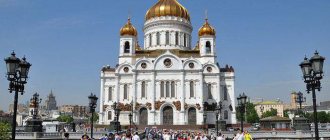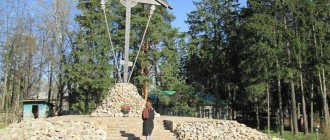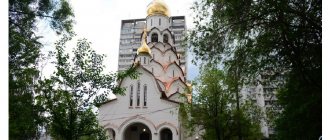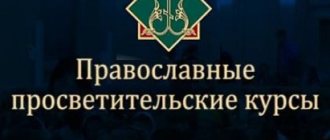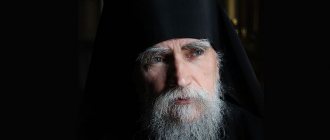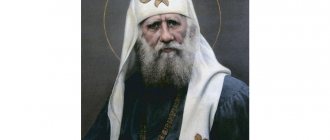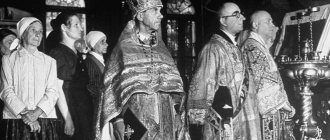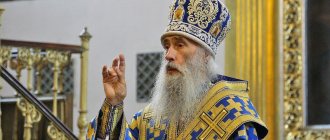History of the icon
Who wrote it?
The icon “The Council of New Martyrs and Confessors of the Russian Church” was also created conciliarly - it was painted by a group of icon painters from the workshop of the Orthodox St. Tikhon’s Theological Institute (now the Faculty of Church Arts of the Orthodox St. Tikhon’s Humanitarian University). This happened in 2000 on the eve of the glorification of the host of new martyrs and confessors at the Jubilee Council of Bishops of the Russian Orthodox Church.
It is no coincidence that it was the icon painters of the St. Tikhon’s Institute who undertook this work. The very idea of collectively glorifying all those who suffered for their faith during the years of Soviet persecution belonged to the rector of this educational institution, Archpriest Vladimir Vorobyov, who personally knew many confessors of the faith of Christ: Sergei Iosifovich Fudel, Abbot Ioann (Seletsky), Hieromonk Pavel (Troitsky), Archpriest Vsevolod Shpiller... To Father Vladimir and the dean of the Faculty of Church Arts of PSTGU, Alexander Saltykov, owned the idea of the icon, while icon painters and teachers of this faculty Tatyana Azarova-Kauts, Tatyana Androsova, Maria Glebova, Natalia Muravyova worked on it with the participation of university students.
Archpriest Vladimir Vorobyov, Archpriest Alexander Saltykov
By that time, the Church had already glorified several of the largest figures among the new martyrs and confessors: in 1989 - His Holiness Patriarch Tikhon; in 1992 - Metropolitan of Kyiv and Galicia Vladimir (Epiphany), as well as Metropolitan of Petrograd and Gdov Veniamin (Kazan) and Grand Duchess Elizabeth Feodorovna; in 1994 - Archpriest Ioann Kochurov; in 1997 - Metropolitan of Krutitsky Peter (Polyansky), Metropolitan of Leningrad Seraphim (Chichagov) and Archbishop of Tver Thaddeus (Uspensky) ... But in the St. Tikhon's Institute, since the early 1990s, an archive of letters and documents with data on the lives and deaths of thousands of others has been collected , lesser-known ascetics. And in the dioceses, the activities of commissions to collect information about locally venerated new martyrs gained momentum.
To celebrate the 2000th anniversary of the Nativity of Christ with a cathedral glorification of all the new martyrs of the Russian Church, both known and unknown, was the idea with which Father Vladimir Vorobyov approached the head of the Synodal Commission for the Canonization of Saints, Metropolitan Juvenal. He supported the idea, and in August 2000, at the Jubilee Council, in which 144 bishops took part, all the famous saints of modern Russian history and “until now not revealed to the world, but known to God” were canonized. The general list included more than 1,200 new martyrs and confessors, both those who had been canonized earlier or were venerated as saints only in certain localities, as well as more than 800 new names. As a result, the host of Russian saints glorified throughout the history of the Russian Church expanded at least three times.
Glorification of the icon “The Council of New Martyrs and Confessors of Russia” at the Jubilee Council in 2000
It was at this Jubilee Council that, in particular, the holy royal passion-bearers were glorified: Emperor Nicholas II, his wife Alexandra Feodorovna and their five children - Olga, Tatiana, Maria, Anastasia and Alexei.
What model was used to paint the icon?
The icon painted for the Council had a predecessor - an icon painted twenty years earlier by Archimandrite of the Russian Orthodox Church Outside of Russia Cyprian (Pyzhov). The Church Abroad glorified the Council of New Martyrs and Confessors back in November 1981, although it separately named only Tsar Nicholas II and members of his family. In the service compiled in honor of the new martyrs, several other persons were mentioned: Patriarch Tikhon, holy martyrs Vladimir of Kiev and Veniamin of Petrograd, Venerable Martyr Elizabeth Feodorovna and a number of others.
And most of all, there were recognizable faces on the icon: for example, the royal servants who were shot along with the family of Nicholas II in Yekaterinburg were present here:
The royal family was depicted on the icon of Archimandrite Cyprian in the very center; it seemed to gather around itself all those who suffered from the godless government. Participants in the ROCOR Council did not dare to declare that in the host of new martyrs and confessors of the 20th century the sovereign occupied a central place, but still called this place “special.” And in the icon, Nicholas II and his family clearly stand out from the many faces glorified on that November day: they stand against the backdrop of the Cathedral of Christ the Savior, directly under the archangel blessing from heaven and the throne located even higher, over which Patriarch Tikhon and the locum tenens of the Patriarchal Throne bowed, Metropolitan Peter (Polyansky) of Krutitsky.
How to paint images of monks?
Now, when depicting hieromonks, abbots, and archimandrites, they are most often depicted in full liturgical vestments, emphasizing their rank. In the ancient tradition, it’s the other way around: a monk, no matter whether he is ordained or not, was always depicted in monastic robes. First of all, he is a monk. This is how they wrote, as already stated earlier, even some bishops, not to mention hierodeacons and hieromonks. Although there are some exceptions, when priest-monks were depicted in liturgical vestments, like the Venerable Theodore the Studite and Marcian. However, the traditional norm is more consistent with the image of presbyter-monks in monastic robes.
Cathedral of Saints of the Moscow Theological Academy
Regarding the depiction of holy monks, another question arises: now monasticism is divided into degrees (monastics, mantle monks (minor schema), great schema monks) - how to display this when writing? Moreover, among the venerable martyrs of the 20th century there are even novices. How to take this into account when painting an icon? There are different approaches. One approach: to depict the saint in exactly the clothes that he wore during his earthly life. For example, we know that the saint was tonsured into the minor schema, which means that they write in his mantle. And if he was a great schema-monk, they write a schema. If a monk, he is depicted on the icon in a cassock. If the novice is still a question for research: how was he dressed? Maybe he only wore a cassock? But another approach is also possible: regardless of how the saint was dressed, they write him in full monastic vestments - since he was already numbered among the ranks of monastics. This approach is also possible. Ancient icon painters turned to it more often. But now, probably, this will not always be appropriate, since historical knowledge about saints today is quite developed and such a discrepancy may confuse someone. And if so, then it is better to avoid such reasons and write according to known data. Still, the icon painter must take into account the realities of perception: the image must be combined with the prototype. Not to cause rejection, but to help establish contact, promote prayerful communication with the saint.
For example, when painting the image of the Venerable Martyr Elizabeth, it is taken into account that the Martha and Mary Convent was special; the abbess and sisters wore predominantly white vestments, although artistically white vestments can rarely be depicted beautifully. Therefore, as a rule, some additional color or shade is introduced to make the image more convincing.
Hieromartyr Joasaph with his life, Dubna
Who is depicted in the icon?
The icon, painted for the Council of the Russian Orthodox Church in 2000, differs from its predecessor primarily in the presence of stamps, that is, individual scenes showing the exploits of individual saints. And in terms of composition, it is in many ways reminiscent of the 1981 icon.
As on the American icon, in the center of the Council of New Martyrs and Confessors is a family of royal passion-bearers : Russian Emperor Nicholas II, his wife Alexandra Feodorovna, daughters Olga, Tatiana, Maria, Anastasia and son, Tsarevich Alexei. Shot in the basement of a house in Yekaterinburg on the night of July 16-17, 1918, they were in the first wave of victims for Christ, and the fate that befell them marked the fate of many thousands of other new martyrs and confessors of the Russian Church. Members of the royal family are dressed in Byzantine imperial dresses - dalmatics. This is a reminder both of the continuity of the Christian faith and of the special position in the Church of the Orthodox monarch, who, according to Byzantine law, was close in status to clergy: he could, unlike ordinary laymen, enter the altar, bless the people, and approve the decisions of those convened by him church councils, etc. According to Father Alexander Saltykov, members of the royal family “personify the God-blessed principle of supreme power and order opposed to chaos.”
Around the royal family are gathered lay people, priests and monks who suffered during the years of persecution of Christians by the godless authorities.
Reverend Martyrs Elizaveta Feodorovna (2) and Varvara Yakovleva (3) , thrown by the Bolsheviks into an abandoned mine near Alapaevsk the night after the murder of the royal family, from July 17 to 18, 1918. Elizaveta Feodorovna is the wife of the Moscow Governor-General, Grand Duke Sergei Alexandrovich Romanov and the sister of Empress Alexandra. After his murder by a terrorist, she devoted herself entirely to serving the sick and disadvantaged people, and founded the Martha and Mary Convent of Mercy, where Varvara Yakovleva also worked.
Archimandrite Sergius (Srebryansky) , confessor of the Martha and Mary Convent, was known as a man of prayer and a man of holy life. After the monastery was closed, he went through a series of prisons and exiles.
Archpriest Sergius Mechev , successor to the work of his father Archpriest Alexy Mechev, who headed the “monastery in the world” - the community of the Church of St. Nicholas in Klenniki. A remarkable confessor and prayer book, in 1931 Father Sergius was “excommunicated from Orthodox life and banned from the priesthood” by the Synod for refusing to remember the godless authorities during worship. He spent many years in exile, where he maintained contact with his spiritual children. Shot in Yaroslavl prison on January 6, 1942.
Archimandrite Sergius (Shein) , secretary of the Local Council of 1917–1918, subsequently played a key role in the Society of United Petrograd Parishes, whose task was to fight against the closure of churches. Shot on August 13, 1922 for resisting the campaign to confiscate church property.
Archpriest Philosopher Ornatsky , rector of the Cathedral of the Kazan Icon of the Mother of God in Petrograd, contributed greatly to the spiritual mission at the front during the First World War, and after the revolution he organized the defense of the Alexander Nevsky Lavra from the encroachments of the crowd. Shot with his sons in October 1918 during the “Red Terror”.
Archpriest John Kochurov , cleric of the Catherine Cathedral in Tsarskoe Selo near St. Petersburg and the first clergyman to suffer after the Bolshevik coup. Previously he served in the North American Diocese, which at that time was headed by Metropolitan Tikhon (Bellavin), the future Patriarch. On October 30, 1917, during the shelling of Tsarskoe Selo, he led a religious procession, the participants of which prayed for an end to the internecine warfare. He was killed by a radical crowd of soldiers, sailors and workers.
Above the royal family is the Patriarchal Throne , on which lies the Gospel, revealed in words: Do not be afraid of those who kill the body but are not able to kill the soul (Matthew 10:28 ). The cross behind the throne symbolizes martyrdom in the name of Christ. Investigators, as a rule, forced the new martyrs and confessors not to renounce Christ or leave the Church, but to name the names of other church people, who in this case would also be threatened with arrest and death. Therefore, the Church equates refusal of denunciation with fulfilling Christ’s commandment: Just as you did it to one of the least of these brothers of mine, you did it to me (Matthew 25:40 ).
Next to the throne are two First Hierarchs of the Russian Church from the initial period of persecution: Patriarch Tikhon (Bellavin) (11) , the first Russian Patriarch in more than two centuries, elected at the Local Council of the Russian Church in October 1917, and Metropolitan Peter (Polyansky) of Krutitsky (12 ) , who acted as Locum Tenens of the Patriarchal Throne from the moment of the death of St. Tikhon (April 7, 1925) until his own execution in the Verkhneuralsk detention center in October 1937. Saints Tikhon and Peter enjoyed enormous authority and respect in the Church, and although the Soviet authorities did everything to isolate them in prisons and camps (for example, Metropolitan Peter was never released after his arrest in December 1925), their uncompromising loyalty to Christ and The Church was known to everyone and continued to inspire the church people even after their death.
Around Saints Tikhon and Peter a host of bishops-confessors and holy martyrs are gathered. Their position above the royal family reminds us that the Church gathers precisely around bishops, whose ministry connects the earthly world with the heavenly world. The bishops must also submit to the worldly power, which only through them becomes legitimate.
Next to Saint Tikhon is depicted Metropolitan Kirill (Smirnov) of Kazan , the first candidate for the position of Locum Tenens of the Patriarchal Throne, named by Patriarch Tikhon, one of the most authoritative bishops of the Russian Church. In 1926, the bishops who remained at large voted by secret ballot in favor of electing St. Cyril as the new Patriarch, but this was not destined to happen: the authorities revealed the correspondence of the bishops and immediately opened criminal cases. He was the unofficial leader of a group of church leaders who were critical of the policy of cooperation with the Bolshevik state, which was pursued since July 1927 by the de facto head of the Russian Orthodox Church in those years, Metropolitan Sergius (Stragorodsky). He spent many years in exile and was shot in Chimkent in November 1937.
Here is Bishop Afanasy (Sakharov) of Kovrov , a holy confessor, in the 1930s an active figure in the “Catacomb Church” (created as an alternative to the “Soviet” one, headed by Metropolitan Sergius of Nizhny Novgorod). He took over control of the Vladimir diocese when Bishop Damian, who headed it, went over to the side of the Renovationists. Passed many exiles (Solovki, Turukhansk region, White Sea-Baltic camps). He composed several services and rites, including a service to all the saints who shone in the Russian land.
Archbishop of Tver and Kashinsky Thaddeus (Uspensky) , faithful companion of Patriarch Tikhon. In 1922, while still at the See of Astrakhan, he was arrested on charges of helping to spread the appeal of Metropolitan Agafangel, who temporarily ruled the Church after the arrest of St. Tikhon, with a call to preserve the purity of the Church and resist the Renovationists. He was distinguished by personal modesty and unpretentiousness. He was slandered by one of the priests, arrested on December 20, 1937, and executed a few days later.
Metropolitan Agafangel (Preobrazhensky) of Yaroslavl is another faithful associate of Patriarch Tikhon, who was among the candidates for the position of Locum Tenens of the Patriarchal Throne. He was in moderate opposition to the policies of Metropolitan Sergius (Stragorodsky). He spent several years in prisons and exile. Died in 1928.
Bishop of Tobolsk Hermogenes (Dolganev) , one of the most conservative bishops of the Russian Church at the beginning of the century, an irreconcilable fighter against revolutionary sentiments. He sharply criticized the attempt to introduce the rank of deaconesses in the Church and denounced Grigory Rasputin. After the revolution, he fearlessly denounced the actions of the Bolsheviks. He was arrested after a large religious procession took place in Tobolsk, where the royal family was kept. In June 1918, he was drowned in the Ture River.
Archbishop of Perm and Kungur Andronik (Nikolsky) , a talented missionary, helped St. Nicholas (Kasatkin) spread the Orthodox faith among the Japanese. He was known as a man of prayer and a non-covetous man, sharply criticized communist ideas and called himself an “open enemy” of the Bolshevik government. After the arrival of Soviet power in Perm, he banned services in all churches in the city. On June 17, 1918, he was arrested, dug his own grave and was buried alive in it.
Metropolitan of Kiev and Galicia Vladimir (Epiphany) , the oldest and most authoritative hierarch of the Russian Church, honorary chairman of the Local Council of 1917–1918. For 14 years he occupied the Moscow department, where he was actively involved in education and missionary work. He became one of the first victims of the revolutionary-minded masses; he was shot at the Kiev Pechersk Lavra on January 25 (February 7), 1918. Before his death he blessed the murderers. The participants of the Local Council held at that time timed the day of remembrance of all new martyrs who suffered from the Bolsheviks to coincide with the day of the death of Metropolitan Vladimir.
Archbishop Hilarion (Troitsky) of Vereya , Patriarch Tikhon’s closest assistant, one of the most active supporters of the restoration of the patriarchate and an active fighter against renovationism? Renovationists are a group of priests and bishops that formed in the early 1920s, who showed demonstrative loyalty to Soviet power and tried to seize power in Churches into their own hands, “deposing” Patriarch Tikhon. They got their name because they actively promoted reforms, in particular, the replacement of the Church Slavonic language with Russian and the introduction of a married episcopate. He was the rector of the Sretensky Monastery after it was returned by the renovationists. In 1923, he was exiled to the Solovetsky camp, where he won the universal love of the prisoners, and once, risking his life, he saved one of the guards from death at sea. He died in 1929 from typhus on the way to a new exile.
Metropolitan Veniamin (Kazan) of Petrograd was elected to the capital's see by the residents of Petrograd, who loved the bishop very much for his simplicity and kindness. After the appearance of Lenin’s decree on the separation of Church and state, the first of the hierarchs addressed the Council of People’s Commissars with an appeal not to go against their own people. He opposed the renovationist schism, for which he sat in the dock and was shot on August 13, 1922.
Metropolitan of Leningrad Seraphim (Chichagov) , a native of the nobility, a military man who became a priest with the blessing of the holy righteous John of Kronstadt. In Soviet times, he fought both renovationism and the most irreconcilable opponents of Metropolitan Sergius (Stragorodsky). He was executed at the Butovo training ground in December 1937, when he was already 81 years old.
In the very top row, the Lord Jesus Christ surrounded by the Mother of God, John the Baptist and Russian saints standing before Him in prayer.
In the central part of the icon we see a symbolic image of the Cathedral of Christ the Savior, the Moscow Cathedral, which shared the fate of the new martyrs - living temples of the Holy Spirit: first it was captured by the renovationists, and in December 1931 it was blown up. At the same time, this is an image of conciliarity, unity in Christ, which binds all the children of the Russian Church who suffered from persecution in the 20th century.
What kind of scenes are depicted around the edges of the icon?
Along the edges of the icon are the so-called hallmarks (or lives) - iconographic fragments depicting the most famous and revealing scenes of massacres, testifying to the feat of the confessors and new martyrs especially fully and convincingly. On the vertical right there are images of the martyrdoms of individual saints, and in the stamps on the left there are mass scenes.
The soldiers in their marshy, earth-colored uniforms are executioners, representing the forces of evil that stand behind them. The figures of the soldiers are deliberately poorly developed graphically: this emphasizes that they are blind instruments of demons fighting against the Church.
The suffering of the holy new martyrs on Solovki
From the beginning of the 1920s, the Solovetsky Islands were turned into a special-purpose camp, where “religious people” were also exiled. At the end of the 1920s, Solovki turned out to be the place of the densest concentration of Orthodox bishops. The stamp depicts two islands of the Solovetsky archipelago - Bolshoi Solovetsky and Anzer. In the center is a monastery with the Transfiguration Cathedral, which became the place of imprisonment. In the foreground is the execution scene. The names of the martyrs are not indicated, so the icon painters showed the massive nature of the executions.
One of the most prominent hierarchs who ended his life on Solovki was Voronezh Archbishop Peter (Zverev). He is depicted resting in the ground under the temple on the island of Anzer. A little higher is the famous birch tree in the shape of a cross.
In the Solovetsky camp there were also Archbishop Evgeniy (Zernov), Archbishop Hilarion (Troitsky) and many other holy martyrs.
Imprisonment in the winter quarters of He and the murder of the Hieromartyr Peter (Polyansky)
The stamp depicts the suffering and death of the Hieromartyr Peter (Polyansky), Metropolitan of Krutitsky, Locum Tenens of the Patriarchal Throne.
Metropolitan Peter was subjected to severe persecution by the authorities almost immediately after accepting the duties of Locum Tenens. He spent many years in solitary confinement in various prisons. For several years he was imprisoned beyond the Arctic Circle, in He’s winter quarters at the mouth of the Ob River. On September 27 (October 10), 1937, Saint Peter, who had suffered after many years of torment, was shot in Chelyabinsk.
Condemnation to death of the Hieromartyr Benjamin and others who suffered with him
Metropolitan Veniamin (Kazan) of Petrograd and Gdov, and with him a large group of clergy and believers, were brought to trial on false charges of resisting the seizure of church valuables. On the night of August 12-13, 1922, Saint Benjamin, along with Archimandrite Sergius (Shein), Yuri Novitsky and Ivan Kovsharov, were put to death.
The high pulpit depicts a judge announcing a verdict. On the scroll in his hand are only the names of the accused: in this way the judge involuntarily testifies to the confessional feat of the saints. Saint Benjamin is depicted with a blessing gesture. Behind the wall, behind the backs of the convicts, are depicted the notorious Petrograd prison “Crosses,” the dome of St. Isaac’s Cathedral and the sea.
Murders of the Hieromartyrs Andronicus and Hermogenes
The stamp depicts the martyrdom of Andronik (Nikolsky), Archbishop of Perm and Solikamsk, and Hermogenes (Dolganev), Bishop of Tobolsk and Siberia. The first, who called himself an open enemy of the Soviet regime, was buried alive in the ground; the second was drowned in the Tobol River with a stone around his neck. Saint Andronicus was an active missionary (he worked in Japan and Siberia), a deep thinker and ascetic, Saint Hermogenes was a brilliantly educated church leader and ascetic. Brutal reprisals against both were carried out almost simultaneously: Bishop Hermogenes died on June 16, and Archbishop Andronik on June 20, 1918.
Destruction of the Trinity-Sergius Lavra and desecration of the relics of St. Sergius of Radonezh
The closure of the Lavra was preceded by the blasphemous opening of the relics of St. Sergius in 1919, which became one of the main events of a broad anti-church campaign for the opening of holy relics. In 1920, the Lavra was closed, and the holy relics were taken to the museum.
There are no bells on the bell tower, which symbolizes the ruin of the monastery.
Murder of the Venerable Martyr Elizabeth Feodorovna and those with her in Alapaevsk
On the night of July 5 (18), 1918, Grand Duchess Elizabeth Feodorovna, her cell attendant Varvara Yakovleva, together with Grand Duke Sergei Mikhailovich, his manager Fyodor Remez, princes Ivan Konstantinovich, Igor Konstantinovich and Konstantin Konstantinovich Romanov, as well as with the son of Grand Duke Pavel Alexandrovich Vladimir Paley, whom Elizaveta Fedorovna raised as her own son, was thrown into an empty mine near Alapaevsk, after which they threw grenades from above.
The holy martyrs are depicted in light, almost white clothes, with their hands folded on their chests as a sign of complete humility and submission to the will of God.
Patriarch Tikhon in captivity in the Donskoy Monastery
Saint Tikhon was involved in a criminal case (he was accused of resisting the seizure of church valuables) and was under arrest from May 1922 to June 1923. The place of imprisonment of the Patriarch was the Donskoy Monastery, where his relics now rest.
The icon depicts the saint giving a blessing to the people from the wall where he was allowed to go. The clergy and people prayerfully turn to the Patriarch. In their person, the Patriarch blesses the entire Orthodox Russian people.
The murder of the holy passion-bearers Tsar Nicholas, Tsarina Alexandra, the Tsarevich, the princesses and their servants in Yekaterinburg
The execution of the royal family and their loyal servants took place in the basement of the house of engineer Ipatiev in Yekaterinburg on the night of July 3 (16) to July 4 (17), 1918. During the previous 17 months, the royal passion-bearers were imprisoned - first in Tsarskoye Selo, then in Tobolsk and, finally, in Yekaterinburg. All these months they behaved like real Christians: they worked, took care of each other and never complained about the often rude treatment.
Shortly before her death, Grand Duchess Olga Nikolaevna wrote in one of her letters: ““Father asks you to tell all those who remained devoted to Him, and those on whom they can have influence, that they do not take revenge for Him, since He has forgiven everyone and for He prays to everyone, both so that they do not take revenge for themselves, and so that they remember that the evil that is now in the world will be even stronger, but that it is not evil that will defeat evil, but only love...”
Mass execution at the Butovo training ground
The Butovo training ground is one of the most terrible monuments of Stalin’s repressions. For a long period, mass executions took place here every day, tens of thousands of innocent people were killed, including many clergy. The convicts were brought in for one night, shot and immediately buried in huge ditches. In just over a year, when the executions were documented - from August 1937 to October 1938 - 20,761 people were killed at the training ground, of which about 1,000 were people of the Church - monks, priests, bishops, etc. More than 300 of them have already been glorified in the guise of the holy new martyrs.
On the stamp they are depicted in the form of two groups, one of which is shot by soldiers, and the other is led to execution. Also visible in the image are two ditches with the bodies of killed martyrs in pink, dark red, green, and purple robes. These bright colors, contrasting with the dark green uniform of the killers, signify the righteousness of the sufferers, their passage into eternal life.
Shooting of the religious procession in Astrakhan
Processions of the cross to protest against the persecution of the Church were held in many cities throughout 1918–1919. This fragment of the icon depicts one of the most massive religious processions against the desecration of churches, led by Archbishop Mitrofan (Krasnopolsky) of Astrakhan, who was shot on June 23, 1919. A group of soldiers shoots at the procession.
Execution and discovery of the body of Hieromartyr Vladimir, Metropolitan of Kyiv
Metropolitan Vladimir (Epiphany) of Kiev and Galicia was the first of the bishops to become a new Russian martyr. Saint Vladimir well understood the danger of revolutionary propaganda and fought against it, especially during his stay at the Moscow See. In Kyiv, the saint firmly opposed the anti-church, schismatic actions of nationalist elements in the Ukrainian clergy. He was arrested in his chambers in the Kiev Pechersk Lavra, taken outside the walls and shot on January 25, 1918. A few minutes before his death, the saint prayed and blessed the murderers.
Arrest of a priest in a church during a service
Numerous cases are known, especially in the first years after the revolution, when persecutors burst directly into the altars at the time of the Divine Liturgy, desecrated shrines, arrested or killed clergy. The icon shows a generalized image of such an attack.
On the throne, covered with red vestments, there are sacred vessels, in front of the throne is a priest in light vestments. The soldiers surrounded the throne, one of them sacrilegiously takes the chalice from the throne, others arrest the priest, whose hands are tied.
On the left side of the stamp there is an unknown woman with children - this is also a generalized image, symbolizing the confessional feat of women during the period of persecution. Unknown nuns, wives and sisters of priests, and ordinary parishioners died in camps and prisons. And those who remained free quietly carried out their Christian service: accompanied the clergy during persecution and exile, stood all night long at the prison doors to make transfers, protected the remaining churches, saved shrines from robbery and destruction, and did not abandon the temple and worship in the most hopeless years. “White handkerchiefs” - that’s what Patriarch Tikhon lovingly called them.
Closing of the Sarov monastery and theft of the relics of St. Seraphim
The Sarov Assumption Hermitage belongs to the most revered holy places of the Russian Church by the Orthodox people. The monastery was closed in 1927, at which time the holy relics of St. Seraphim were removed from it.
Against the background of a pink bell tower, two soldiers carry away the coffin with the remains of the monk; a soldier drives the inhabitants of the monastery in the other direction.
Murder of Hieromartyr Kirill, Metropolitan of Kazan
The last mark of the icon depicts the execution of the most authoritative hierarch of the Russian Church after Patriarch Tikhon and Metropolitan Peter of Krutitsa - St. Kirill (Smirnov). For several years, bishops united around him, disagreeing with the policy of loyalty to the state, which was pursued by the acting leader. O. Deputy Locum Tenens of the Patriarchal Throne, Metropolitan Sergius (Stragorodsky). At the same time, being in opposition to this policy, Saint Cyril never deviated into schism and did not call on his supporters to boycott the services of the “Sergian” bishops.
Metropolitan Kirill was killed in Chimkent (southern region of Kazakhstan) on November 7 (20), 1937. His hands are stretched out in prayer, and his liturgical robes of red-crimson color contrast sharply with the swampy-greenish silhouettes of the executioners.
Prepared by I. Tsukanov
|
